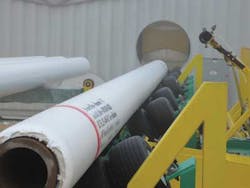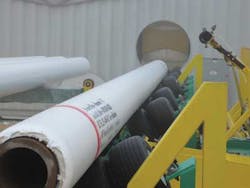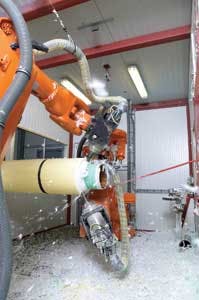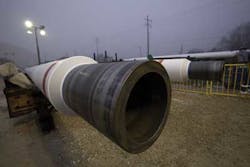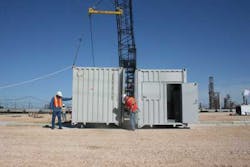Robotics improve insulated pipe cutbacks
Tor Bredeli
Paul Kleinen
Arno Wainikainen
Bredero Shaw
As the search for energy moves further offshore, the demands placed on pipelines and flow assurance systems increase. Pipelines are made of individual pieces of pipe, welded together, and plant-applied insulation is complemented with insulation applied in the field: a field joint.
However, prior to joining pipe together, a "cutback" must be prepared to remove insulation from the welding area. After the weld is inspected and accepted, the exposed area must be insulated.
Bredero Shaw has developed and commercialized a robotic technology for preparing cutbacks safely and reliably, and was recently recognized for this accomplishment with a 2013 Spotlight on New Technology Award from the Offshore Technology Conference (OTC).
Offshore pipe preparation
Flow assurance is the term used to describe the technologies used to maintain the flow of oil and gas in a pipeline. Because both oil and gas may contain substances that can solidify at lower temperatures and obstruct flow, thermal insulation is a key element of most flow assurance systems. To meet the demanding requirements of offshore pipelines, thermal insulation is often applied in plants using manufacturing processes designed to assure corrosion protection, thermal insulation, bonding of different system elements to each other, and field joints to deliver a fully integrated system capable of reliable operation in a range of challenging conditions.
As with many engineered systems, overall performance requires consistency at the interfaces and, with insulated pipelines, an interface is created every time a pipe is welded to another pipe of point of connection. With offshore pipelines ranging in length from a few kilometers to hundreds of kilometers, there can easily be over 10,000 interfaces in the pipeline itself. This establishes the requirements for safe and reliable cutbacks on the ends of an insulated pipe.
Cutbacks are manufactured on each end of insulated pipe with typical diameters of 8 to 24 in. and with up to 120 mm (4.7 in.) of insulation. Typical cutback specifications require a combination of bare steel; a transition area or "toe" of fusion bond epoxy (FBE) at the point where the steel meets the insulation; and a conical chamfer face at an angle of 30°, free of burrs or irregularities. The manufacturing process requires a cutback cycle time of approximately 20 minutes (depending on pipe diameter and insulation thickness).
In addition, the following requirements are derived from manufacturing:
- Reliable: Technology needs to support extended operations of 24/6
- Safe: Minimize man/machine contact. Adapt to multiple geometries while minimizing risk of contact between cutting tool and pipe
- Capable: Produce consistent profile geometry within 1 mm +/- 1°, throughput of three to four joints per hour
- Flexible: Chamfer angle, cutback length, FBE toe, PP toe, shear rings, windows for FJ trials
- Rapid changeovers: Ability to quickly change from one cutback geometry and type to another
- Cost effective: Capital and operating costs must be consistent with effective plant economics.
A preliminary technology evaluation identified significant shortcomings in common existing manufacturing processes such as wire brushing, scraping, and grinding:
- Labor intensive: One person is required for each end of the pipe for each shift
- Limited geometry: Only simple shapes can be manufactured
- Safety hazards: Intensive man/machine involvement entails many hazards including hand injury, dust, objects in the eye, and fatigue
- High cost: Brushing and scraping systems have high labor and maintenance costs
- Long cycle time: Brushing and scraping are inefficient, requiring frequent tool changes
- Variability: Manual and other "brute force" processes suffer from variability in the final product
- Mobility: Fit within Brigden, Bredero Shaw's coating technology platform.
Search for new technology
Considering the shortcomings of conventional cutback technology, the search was expanded and industrial robots were identified as potential candidates. However, this technology was relatively new to the industry and concerns included maintenance, training, and high initial cost.
Industrial robots have been used in many industries to perform tasks of intermediate complexity like welding and painting, but a mobile machining solution was unavailable. Even so, industrial robotic technology offered several key advantages such as:
- Enhanced safety: People are not a part of or close to the milling process. The risk of personal injury is engineered out
- Reliability and capability: Robot technology is reliable and can be depended upon to work continuously and with great precision
- Flexibility: Robots can be configured quickly and reliably to perform different cutback machining geometries on a range of pipe diameters, insulation thickness, chamfer angles, and can even prepare complex stepped cutbacks and test specimens.
After evaluation and comparisons of technologies, the decision was reached to adapt proven robotic technology to pipe coating and the task of creating cutbacks on coated line pipe. The cost premium was slight but the performance improvement opportunity was significant.
Next steps
The next step in the technology selection process was to incorporate industrial robotics into a integrated solution that included pipe-handling systems for receiving and moving fully coated and finished line pipe; cutting tools for the robots to remove a variety of coating types; power; safety systems; integrated controls; and waste (cuttings) management.
A significant amount of small and intermediate-scale testing was performed to establish the operating capability of different cutting tools, estimate production rates, and establish a performance envelope. These elements came together first in a robotic solution (arms, tooling, power supply, control system) and were then combined with a pipe-handling system, waste removal system, and an integrated PLC control system. The result is a mobile, modular cutback system which delivers precision cutbacks wherever these services are needed.
Mobility represented a significant design challenge, because the robotic cutback system was to be used in concert with the Brigden mobile modular coating technology. In order to meet requirements for global mobility and modularity, 100% of the robotic cutback system must fit within a standard ISO container, and the system must resist impact loads experienced in transit. This created the opportunity for innovative design. Several different layout options were developed and analyzed using criteria such as space utilization, portability, safety, and ease of operation.
The final choice uses two modified ISO containers; a modular rack and conveyor system for pipe handling; a dust collector to remove cut material from the work area and package the chips; and a containerized power and control system. Technical support at remote sites is facilitated by a PLC that can be accessed remotely via a secure Web connection, while a webcam enables visual contact from anywhere in the world.
Component selection
The engineering team developed a system specification and used it to guide selection of individual components for the system. When introducing new technology to the workplace, consideration needs to be given to factors such as process safety, maintenance and spares, and operator training. Safety professionals were included in the design team and given opportunities to make proactive recommendations to improve the finished product.
Although maintenance and spares are simple, the new technology platform did require some specialized provisioning. But the big challenge was operator training. The robotic technology requires no operator presence in the work area. All process activities are controlled remotely either through programming or a pad style, pendant mounted controller. With a user interface resembling that of a video game, it was easy to select operators with an aptitude for this style of tool.
Training included a two-week program, conducted offsite, performing progressively challenging tasks using scale models of the full system. It then progressed to supervised onsite cutting operations using prototype pipe. After onsite commissioning was completed, the first cuts were made on sample pipe and then a transition was made to low-volume production. The air of uncertainty was quickly dispelled and the robots moved from novelty to reliable high-tech production tools.
Current status
Robot cutback technology has now been used successfully on dozens of projects and has proven to be safe and reliable. The original investment was justified on the basis of conservative improvements in productivity and reduced maintenance cost, but the benefits in areas such as improved first-time quality and throughput have proven to be at least as important, if not more so. A cadre of robot operators is now trained and able to set up, calibrate, test, and operate the robots. A preventive maintenance program is in place and basic troubleshooting skills are being built. One additional environmental benefit was also realized: the ability to recycle the cuttings. The dust collector deposits the chips in a debris container and these are reused.
Offshore Articles Archives
View Oil and Gas Articles on PennEnergy.com
